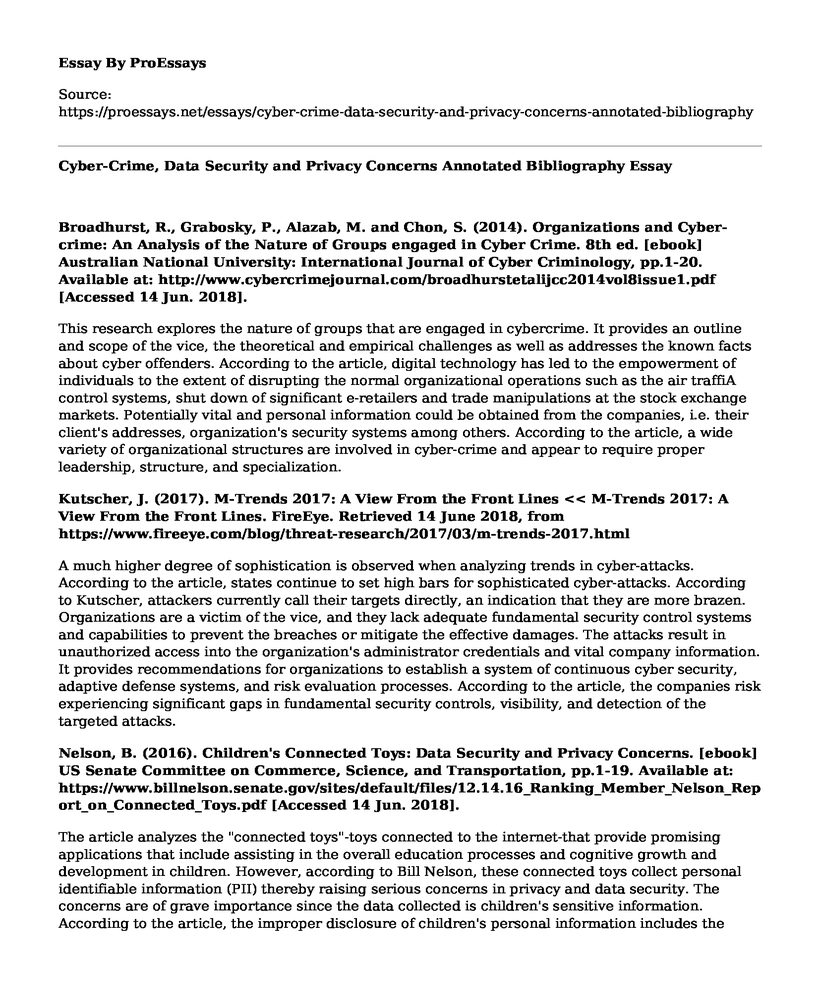Broadhurst, R., Grabosky, P., Alazab, M. and Chon, S. (2014). Organizations and Cyber-crime: An Analysis of the Nature of Groups engaged in Cyber Crime. 8th ed. [ebook] Australian National University: International Journal of Cyber Criminology, pp.1-20. Available at: http://www.cybercrimejournal.com/broadhurstetalijcc2014vol8issue1.pdf [Accessed 14 Jun. 2018].
This research explores the nature of groups that are engaged in cybercrime. It provides an outline and scope of the vice, the theoretical and empirical challenges as well as addresses the known facts about cyber offenders. According to the article, digital technology has led to the empowerment of individuals to the extent of disrupting the normal organizational operations such as the air traffiA control systems, shut down of significant e-retailers and trade manipulations at the stock exchange markets. Potentially vital and personal information could be obtained from the companies, i.e. their client's addresses, organization's security systems among others. According to the article, a wide variety of organizational structures are involved in cyber-crime and appear to require proper leadership, structure, and specialization.
Kutscher, J. (2017). M-Trends 2017: A View From the Front Lines << M-Trends 2017: A View From the Front Lines. FireEye. Retrieved 14 June 2018, from https://www.fireeye.com/blog/threat-research/2017/03/m-trends-2017.html
A much higher degree of sophistication is observed when analyzing trends in cyber-attacks. According to the article, states continue to set high bars for sophisticated cyber-attacks. According to Kutscher, attackers currently call their targets directly, an indication that they are more brazen. Organizations are a victim of the vice, and they lack adequate fundamental security control systems and capabilities to prevent the breaches or mitigate the effective damages. The attacks result in unauthorized access into the organization's administrator credentials and vital company information. It provides recommendations for organizations to establish a system of continuous cyber security, adaptive defense systems, and risk evaluation processes. According to the article, the companies risk experiencing significant gaps in fundamental security controls, visibility, and detection of the targeted attacks.
Nelson, B. (2016). Children's Connected Toys: Data Security and Privacy Concerns. [ebook] US Senate Committee on Commerce, Science, and Transportation, pp.1-19. Available at: https://www.billnelson.senate.gov/sites/default/files/12.14.16_Ranking_Member_Nelson_Report_on_Connected_Toys.pdf [Accessed 14 Jun. 2018].
The article analyzes the "connected toys"-toys connected to the internet-that provide promising applications that include assisting in the overall education processes and cognitive growth and development in children. However, according to Bill Nelson, these connected toys collect personal identifiable information (PII) thereby raising serious concerns in privacy and data security. The concerns are of grave importance since the data collected is children's sensitive information. According to the article, the improper disclosure of children's personal information includes the name, home, address, physical location, online contact information and physical location. Access to this vital information could lead to inappropriate contact, abduction and even sexual exploitation. The article explains how the data becomes a target for identity thieves and bad actors who can use the information to create false identities and engage in financial frauds and other crimes.
Roberts, L., Indermaur, D. and Spiranovic, C. (2012). 315-328. [online] Journal of Psychiatry, Psychology, and Law. Available at: http://www.tandfonline.com/doi/abs/10.1080/13218719.2012.672275 [Accessed 14 Jun. 2018].
The article provides an analysis of a study on the fear of cyber-identity theft and related fraudulent activities. According to the study, an estimate of one person in every twenty five adults across the western societies experience identity theft and its related fraudulent activities each year. In this case, the victims of the online cyber-attacks are the internet users. The article talks of the internet as an avenue to obtain identity tokens, identify victim's information and enhance the scale of perpetrating identity theft. The fear of this crime overrides that of traditional place-based crimes and can curtail online activities as well as the development of e-commerce processes. The article conducts exploratory research that identifies the predictors of fear of cyber-identity theft and its related fraudulent acts. According to the study, the predictors of fear included a generalized anxiety of the criminal components and exposure to specific internet components.
Cite this page
Cyber-Crime, Data Security and Privacy Concerns Annotated Bibliography. (2022, Jun 17). Retrieved from https://proessays.net/essays/cyber-crime-data-security-and-privacy-concerns-annotated-bibliography
If you are the original author of this essay and no longer wish to have it published on the ProEssays website, please click below to request its removal:
- Digital Connections and Relationships Essay Example
- Cybercrime: Local to Global Essay Example
- Hustler Magazine v. Falwell: Supreme Court Ruling in Favor of Magazine - Case Study
- Essay on Identifying Communication Strategies in Broward Co. Bond Court
- Essay Example on Why Organizations Hire Hackers: Exploring Reasons & Strategies
- Paper Sample on Google Searches - Technology Making the World a Global Village
- Free Essay Sample on Mental Illness in Prisons







